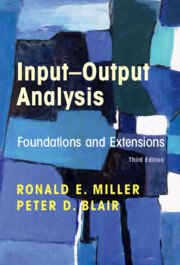Book contents
- Input–Output Analysis
- Input–Output Analysis
- Copyright page
- Contents
- Figures
- Tables
- Preface
- 1 Introduction and Overview
- 2 Foundations of Input–Output Analysis
- 3 Input–Output Models at the Regional Level
- 4 Organization of Basic Data for Input–Output Models
- 5 The Commodity-by-Industry Approach in Input–Output Models
- 6 Multipliers in the Input–Output Model
- 7 Supply-Side Models, Linkages, and Important Coefficients
- 8 Decomposition Approaches
- 9 Nonsurvey and Partial-Survey Methods:
- 10 Nonsurvey and Partial-Survey Methods:
- 11 Social Accounting Matrices
- 12 Energy Input–Output Analysis
- 13 Environmental Input–Output Analysis
- 14 Mixed and Dynamic Models
- 15 Additional Topics
- Postscript
- Book part
- Author Index
- Subject Index
- References
9 - Nonsurvey and Partial-Survey Methods:
Fundamentals
Published online by Cambridge University Press: 06 January 2022
- Input–Output Analysis
- Input–Output Analysis
- Copyright page
- Contents
- Figures
- Tables
- Preface
- 1 Introduction and Overview
- 2 Foundations of Input–Output Analysis
- 3 Input–Output Models at the Regional Level
- 4 Organization of Basic Data for Input–Output Models
- 5 The Commodity-by-Industry Approach in Input–Output Models
- 6 Multipliers in the Input–Output Model
- 7 Supply-Side Models, Linkages, and Important Coefficients
- 8 Decomposition Approaches
- 9 Nonsurvey and Partial-Survey Methods:
- 10 Nonsurvey and Partial-Survey Methods:
- 11 Social Accounting Matrices
- 12 Energy Input–Output Analysis
- 13 Environmental Input–Output Analysis
- 14 Mixed and Dynamic Models
- 15 Additional Topics
- Postscript
- Book part
- Author Index
- Subject Index
- References
Summary
Chapter 9 introduces approaches designed to deal with the major challenge in input–output analysis that the kinds of information-gathering surveys needed to collect input–output data for an economy can be expensive and very time consuming, resulting in tables of input–output coefficients that are outdated before they are produced. These techniques, known as partial survey and nonsurvey approaches to input–output table construction, are central to modern applications of input–output analysis. The chapter begins by reviewing the basic factors contributing to the stability of input–output data over time, such as changing technology, prices, and the scale and scope of business enterprises. Several techniques for updating input–output data are developed and the economic implications of each described. The bulk of the chapter is concerned with the widely utilized biproportional scaling (or RAS) technique and some related “hybrid model” variants.
Keywords
- Type
- Chapter
- Information
- Input-Output AnalysisFoundations and Extensions, pp. 400 - 440Publisher: Cambridge University PressPrint publication year: 2022



